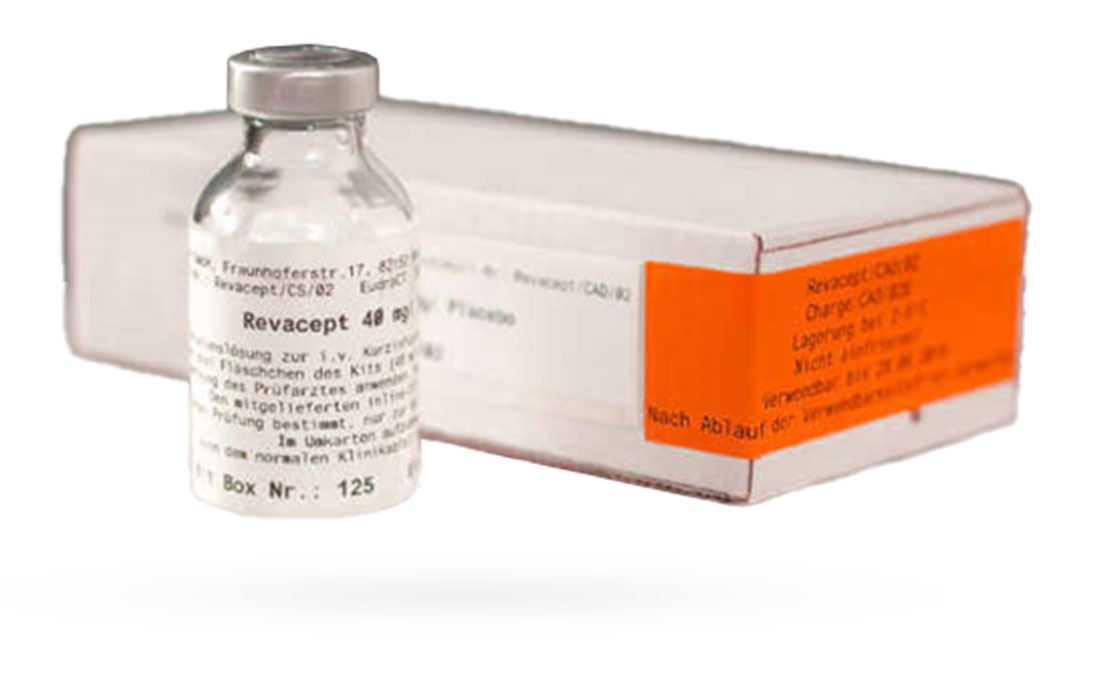AdvanceCOR
Pipeline
Revacept in detail

Arterial Disease and
Thrombus Formation
Peripheral arterial disease (PAD), stroke and heart attack are the most severe complications of pathological changes in the arteries during atherosclerosis. In a first stage, platelets bind and get attached to a damaged vessel wall, for example after plaque rupture. They become activated and attract more and more platelets. Thereby a thrombus is formed which may literally seal the blood vessel. Some parts of the blood clot can detach, float away with the bloodstream and plugg smaller blood vessels and areas behind the blockade. The tissue or whole organs are no longer supplied with blood and oxygen. This is particularly dangerous in the brain and heart, where the obstruction of blood flow can result in a stroke or heart attack. But also blockade of peripheral arteries leads to critical limb ischemia with deleterious consequences and high mortality.

GPVI and Revacept
in Preventing
Thrombus Formation
A crucial factor in this process is the attachment of platelets to the blood vessel wall. One major receptor on the platelet membrane is glycoprotein VI (GPVI). The extracellular part of GPVI binds to collagen fibers exposed at sites of vessel wall rupture. Schematic diagram of how platelets attach to a damaged vessel wall in atherosclerosis. If a plaque tears, blood clots can form, leading to the blockage of blood vessels by a thrombus. Revacept forms a patch for the damaged vessel wall and prevents the thrombus formation at the site of the incident. Revacept is a recombinant protein composed of the extracellular part of GPVI fused to the Fc-part of human antibodies. There are already several Fc-fusion proteins applied successfully in treatment of various diseases. However, Revacept is the first Fc-fusion protein to be used as pharmaceutical in stroke and heart attack. With its GPVI component, Revacept binds to damaged blood vessel walls, covers them and thus forms a kind of vascular patch. This prevents the formation of thrombi in the arteries. However, unlike all other drugs used to treat stroke and heart attack, Revacept does not increase the risk of bleeding. The general haemostasis remains unaffected – and this is the decisive advantage of Revacept over conventional drugs.
Clinical Testing and
Effectiveness of
Revacept
Revacept has proven to be very effective in laboratory tests with platelets and in preclinical studies. In a Phase I clinical trial with volunteers, it was shown to be very well tolerated at all tested dosages up to 160 mg. It induced a specific and dose-dependent inhibition of aggregation (clotting of platelets) in the blood of the volunteers without any relevant side effects. In particular, general haemostasis was not affected: The bleeding time was not prolonged by Revacept and there were neither incidences of bleeding complications nor reductions in platelet count (thrombocytopenia).The first multi-centre Phase II clinical trial (registered under NCT01645306) in 158 patients showed beneficial effects of Revacept in patients with carotid stenosis. The patients had undergone intervention (surgery or catheter treatment) after minor strokes or transient ischaemic attacks (TIA, a stroke that lasts only a few minutes). They were given Revacept before the intervention to prevent complications caused by thrombi, which can cause small strokes during or after the intervention. The protocol of the study has been published (Gröschel et al.,Thrombosis and Heamostasis open, 2020). During the same phase II study, Magnetic Resonance Imaging (DWI-MRI) showed that Revacept significantly reduced the number of new brain infarctions associated with the intervention: In the group treated with 120 mg of Revacept, these infarctions were reduced by 46 % compared to placebo; in the group treated with 40 mg of Revacept, the reduction was still 10 percent. The patients had an overall clinical benefit with significantly reduced combined endpoints of bleeding and ischaemic complications (“net clinical benefit”). The study is published by Uphaus et al. 2022.

Ongoing
Development and
Future Prospects
The second study was initiated and led by clinical researchers of the German Centre for Cardiovascular Research (DZHK). This so-called “ISAR-PLASTER” study with 332 patients suffering from stable coronary heart disease was conducted by the teams of Prof. Dr. Adnan Kastrati from the German Heart Centre Munich (DHM) and Prof. Dr. Steffen Massberg from the Großhadern Clinic of the University of Munich together with medical doctors from other large hospitals in Germany. The study is registered under NCT 03315285 and Eudra-CT 2015-000686). Its protocol is published by Schüpke et al. in Thrombosis and Haemostasis, 2019). Efficacy of Revacept treatment was demonstrated by functional analyses: despite maximum conventional therapy, Revacept additionally inhibited platelet aggregation specifically. The outcome of the clinical study shows further, that Revacept did not increase bleeding complications in patients or other safety issues. However, the primary endpoint of death or myocardial injury was not reached, possibly because technical problems during stenting such as side branch occlusion cannot be addressed by the local effect of Revacept. The study is published in JAMA Cardiology by Mayer et al. in JAMA Cardiol., 2021. The current status of development of antiplatelet drugs was summarised in a review in 2019 (Arjun Majithia and Deepak Bhatt, Arterioscler Thromb Vasc Biol., 2019). This independent review underlines the special benefits of Revacept as a specific thrombosis inhibitor without increased risk of bleeding. Revacept has been developed together with companion diagnostics to provide early and tailored treatment for patients at high risk of arterial thrombosis. The diagnostics uses the fact that soluble GPVI (sGPVI) is released as an early biomarker of platelet activation. First evaluations raised from the phase II ISAR-PLASTER study are published by Lahu and Adler et al, 2023. In patients with high sGPVI levels, it is hypothesised that the administration of Revacept can specifically prevent the occurrence of thrombosis without affecting or even reducing bleedings as part of a personalised therapy. Currently, Revacept is being prepared to get phase III ready: We have established large scale production in the fed batch process together with Bibitec/Nordmark. The application as an investigational new drug (IND) at the Federal Drug Agency (FDA) is being prepared to get approval for a phase III study in the United States.

